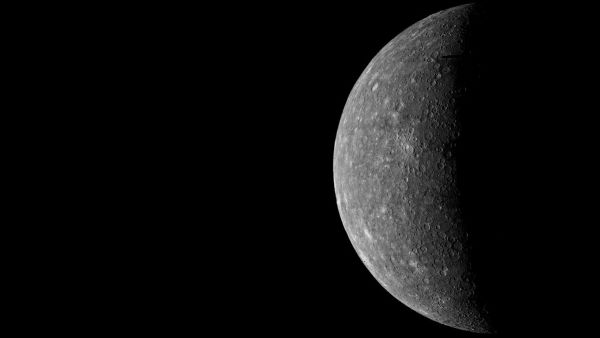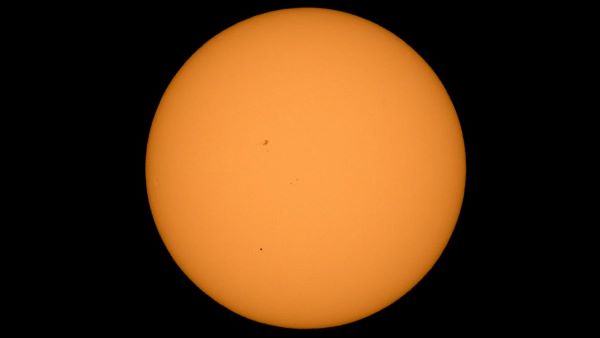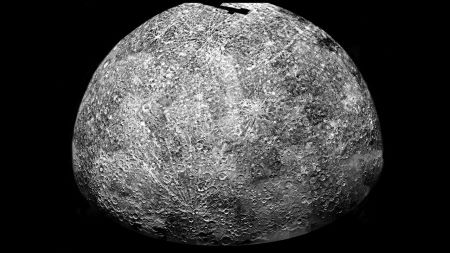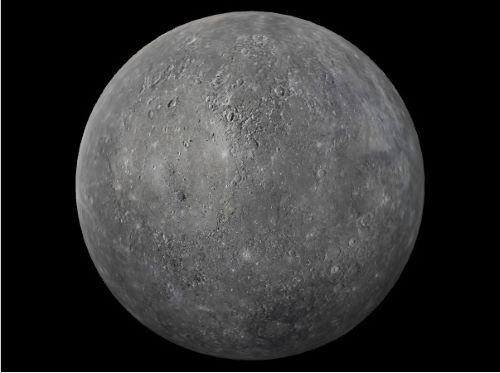Fun Fact about Mercury
Mercury, the planet closest to the sun, is cratered and only a little bigger than the moon on Earth.
Mercury is the eighth-largest and innermost planet in the solar system.
Due to its small size and closeness to the sun, it is the most elusive planet observable to the naked eye.
As its rise and fall occur consistently within a two-hour time span from the sun's, it remains invisible during periods of complete darkness in the sky.
The designated symbol for Mercury is ☿.
The planet has long been recognized by humans as being visible to the naked eye.
The planet in question was referenced by the Sumerians as early as the 2nd millennium BC (approximately 2000 BC to 1001 BC), and the Babylonians designated it Nabu, according to Universe Today.
It was originally designated by the Romans as Mercury, their messenger god, renowned for his speed.
Galileo Galilei and Thomas Harriot used a newly developed telescope to make the planet's initial discovery in 1631, according to NASA Science.
Since its initial scientific observation by the Mariner 10 spacecraft of NASA in 1974, the dwarf planet has captivated researchers.
Particularly after the joint European Space Agency (ESA) and Japan Aerospace Exploration Agency (JAXA) mission BepiColombo makes landfall on the small planet in late 2025, it will undoubtedly continue to amaze us.
Preface
The temperatures at the surface of Mercury are both extremely high and low.
Due to the planet's closeness to the sun, maximum daytime temperatures can attain 800°F (430°C).
In the absence of an atmosphere to retain that heat, nighttime temperatures can fall to -290°F (-180°C).
Although Mercury is near the Sun, its dense atmosphere prevents it from being the warmest planet in our solar system.
That distinction goes to the neighboring planet Venus.
Mercury, however, is the fastest planet, revolving around the Sun in 88 Earth days.
Naming
Mercury is an appropriate name for the most agile of the ancient Roman gods.
Possibility for Life
The atmosphere of Mercury is hostile to life as we know it.
Probably, the solar radiation and temperatures that define this planet are too extreme for life to adjust to.
The size and Distance
Mercury, with a radius of 2,440 kilometres (1,516 miles), is slightly larger than one-third the width of Earth.
Mercury is roughly the size of a blueberry, if Earth were to scale to the size of a penny.
Mercury's average distance from the Sun is 58 million kilometres (36 million miles).
At this distance, Mercury is 0.4 astronomical units from the Sun.
A distance of one astronomical unit (AU) defines the distance between the Sun and Earth.
From this distance, the duration of sunlight's journey from the sun to Mercury is 3.2 minutes.
1. Mercury was named after a Roman god.

The Romans thought that everything in the world was run by gods and goddesses.
Mercury derives its name from the divine messenger.
This name is suitable because the Roman god Mercury wore wings on his helmet and shoes.
He could travel from one location to another at the same rate as Mercury orbits the sun.
2. A crater on Mercury is named in honor of Dr. Suess.
Mercury's craters are named for notable artists and poets.
One of these craters is named Geisel after Theodor Seuss Geisel, also known as Dr. Seuss.
3. The largest fluctuations in Temperature in the Solar System.

The NASA Mariner 10 spacecraft made its first visit to Mercury, which produced this image. (Photo courtesy of NASA, JPL, and USGS.)
Despite being at the closest distance to the sun, Mercury maintains an exceptionally frigid surface due to the absence of a heat-retaining atmosphere.
NASA reports that the minimum nighttime temperature can drop to minus 290 degrees Fahrenheit (minus 180 degrees Celsius).
The maximum daytime temperature can reach an extreme of 800 degrees Fahrenheit (430 degrees Celsius).
That temperature variation of approximately 1,100 degrees Fahrenheit (600 degrees Celsius) is the greatest of any planet in the solar system.
4. Mercury's surface has ice on it.
NASA's MESSENGER spacecraft discovered water ice in some of Mercury's craters back in 2012.
Mercury's closeness to the sun may make you wonder how it could have any surface ice.
However, some portions of Mercury receive very little direct sunlight, and some craters are permanently black.
5. The Solar System's smallest Planet

Mercury, being the smallest planet in the solar system, may potentially continue to undergo shrinkage at present. (NASA/JHUAPL/Carnegie Institution of Washington/USGS/Arizona State University provided the image.)
Mercury is the solar system's tiniest planet. With a diameter of around 3,030 miles (4,876 kilometers), the small planet is roughly equal in width to the continental United States and merely marginally larger than the moon of Earth.
Ganymede, the moon of Jupiter, and Titan, the moon of Saturn, are both larger than Mercury.
Mercury has been declared the smallest planet in the solar system after Pluto's reclassification as a dwarf planet in 2006.
Pluto was previously acknowledged as the smallest planet in the solar system.
6. A day on Mercury spans 59 Earth days.
Because Mercury moves so slowly, it takes 59 Earth days to complete one full rotation.
7. Great Asteroid Impact Survivor
A monochromatic mosaic is superimposed with an enhanced-color composite to form this mosaic image of the Caloris Basin.
NASA/Johns Hopkins University Applied Physics Laboratory/Carnegie Institution of Washington provided the image (credit:
8. Mercury's year is only 88 Earth days.
Mercury orbits the Sun in a relatively short period of time due to its closeness to it. This makes the years on Mercury extremely short.
This means that if you lived there, you'd celebrate New Year's once every three months.
9. A Peculiar Orbit

A photograph of Mercury crossing the sun is located in the lower third of the image. (Photo courtesy of NASA/Bill Ingalls)
According to NASA, Mercury travels at a velocity of nearly 29 miles (47 kilometers) per second as it orbits the sun every 88 Earth days.
Compared to other planets in the solar system, this is the fastest.
Mercury's orbit is exceptionally elliptical and extremely rapid.
The planet's distance from the sun varies between 42 million miles (70 million km) and 29 million miles (47 million km).
10. The spacecraft Mariner 10 and MESSENGER have had the opportunity to travel to the planet Mercury.
Mariner 10 was an American robotic space probe launched by NASA on November 3, 1973, to pass past the planets Mercury and Venus.
The first mission to explore Mercury was NASA's Mariner 10.
MESSENGER was a NASA robotic spacecraft that orbited Mercury from 2011 to 2015, examining its chemical composition, geology, and magnetic field.
11. Surface Ice Found near the Poles

(Photo courtesy of NASA/MESSENGER)
Mercury's poles contain constant ice despite the planet's extremely high temperature, according to data and images from the MESSENGER probe, which orbited Mercury from 2011 to 2015.
NASA's MESSENGER spacecraft identified water ice within several craters on Mercury in 2012.
It was confirmed in 2017 that Mercury's north polar region is covered in significantly more ice than was thought before.
Since the 1990s, when Earth-based telescopes detected highly reflective areas in the polar regions, the existence of ice has been predicted.
Mercury's nearness to the sun may cause some individuals to perceive the presence of surface ice as peculiar.
However, due to the planet's negligible axial inclination, certain craters are constantly hidden from direct sunlight, and the polar regions receive very little of it.
Also, Mercury lacks a visible atmosphere, resulting in its temperatures experiencing significant variations throughout the day and night.
12. Giant Iron Core

Long a subject of scientific enigma, the composition of Mercury's nucleus remains unknown. (Photo courtesy of the Goddard Space Flight Center of NASA)
The diameter of Mercury's enormous metallic core ranges from 3,600 to 3,800 kilometres (2,200 to 2,400 miles), or approximately 75% of the planet's diameter.
To provide some context, the thickness of Mercury's outer shell is a mere 300 to 400 miles (500 to 600 km).
Iron is more abundant in the massive core than on any other planet in the solar system.
Scientists are uncertain as to how it originated or the reason for its incredibly enormous size.
AMESSENGER, an acronym for Mercury Surface, Space Environment, Geochemistry, and Ranging Mission, a NASA spacecraft that spent over four years in Mercury's orbit, transmitted stunning images of the sun's nearest planet.
Employing those images, scientists made the first-ever thorough map of Mercury's surface.
13. Crazy "Tails"

A photomosaic depicting the southern part of Mercury, compiled from images acquired by the NASA Mariner 10 spacecraft. (Photo courtesy of NASA/JLP)
Similar to a comet, scientists have observed streams of debris falling from Mercury's surface.
Astrophotographers on Earth can capture these interesting traces in long-exposure photographs, as explained in an article from EarthSky.
The tails have been thought to be generated through the stimulation of sodium in Mercury's exosphere by solar radiation, according to scientific consensus.
NASA Science reports that sunlight can also release these molecules from Mercury's surface and propel them into space.
14. The entire surface of it has been mapped.

The exosphere of Mercury is exceedingly narrow. NASA/Johns Hopkins University Applied Physics Laboratory/Carnegie Institution of Washington provided the image (credit:
Mercury is the planet within the solar system with the narrowest atmosphere.
Due to its extremely thin atmosphere, it is also referred to by scientists as the exosphere.
NASA reports that the exosphere of Mercury consists primarily of oxygen, sodium, hydrogen, helium, and potassium.
15. Tornadoes of Magnetic Energy
The surface of Mercury is adorned with craters.
Scientists are perplexed by Mercury's magnetic field; despite its diminutive size, the planet manages to sustain a global magnetic field.
Even though Mercury's magnetic field is only 1% as powerful as that of Earth, it is still capable of generating considerable disturbance on the planet's surface via magnetic cyclones.
NASA reports that when the magnetic field of Mercury interacts with the solar wind, magnetic tornadoes are occasionally produced, which direct plasma from the solar wind that is both rapid and hot towards the surface of the small planet.
The impact of solar wind plasma on Mercury's surface causes the displacement of neutrally charged atoms, thereby launching the loops into the upper atmosphere of Mercury.
COMMON QUESTIONS CONCERNING MERCURY
What is the size of Mercury?
Mercury is 74,797,000 km2 in surface area, with a radius of approximately 2,440 km. It has 3.30 x 1023 kg of mass.
In terms of both mass and size, Mercury is the smallest main planet.
Are there any moons on Mercury?
No. One of the two planets in the solar system without a moon is Mercury. Venus is the other.
The reason for this, according to astronomers, is that it is too small and has insufficient gravity to hold on to a moon.
Its closeness to the sun may be another reason.
Why is Mercury difficult to observe?
Mercury is a difficult planet to see with the naked eye because it is the smallest and the planet nearest to the Sun in the solar system.
Mercury is never seen when the sky is completely black since it always rises or sets within two hours of the Sun.
Has anyone ever visited Mercury as a human?
No. There are very few unmanned spacecraft that have been sent to investigate the planet.
Mercury has one of the most unfavourable climates for humans since it is so close to the Sun.
It is unlikely that a manned expedition to Mercury will take place very soon.
How far apart from the sun is Mercury?
Mercury has the shortest year (88 days), and the average orbital distance from the Sun is 58 million km (36 million miles).
On the contrary, Earth's average distance from the Sun is approximately 150 million kilometers, or 93 million miles.
Which element makes up Mercury?
Among the four terrestrial planets in the Solar System is Mercury.
This indicates that its composition is firm and stony.
Its core is primarily iron, and astronomers believe that it is composed of 30% silicates and 70% other metallic elements.
What is the temperature range of Mercury?
The term "hot poles" refers to two places on Mercury's equator where surface temperatures can rise above 700 kelvins (K; 800 °F, 430 °C).
Mercury experiences long nights before daybreak, with surface temperatures dropping to roughly 90 K (−300 °F, −180 °C).
Is water present on Mercury?
Yes. Mercury has craters that are constantly hidden from the Sun, and the MESSENGER spacecraft has confirmed that some of these craters contain small ice deposits.
Still, liquid water is improbable.
Mercury's spectrum scan helps us learn more about the composition of the planet. Credit: Carnegie Institution of Washington, NASA, and Johns Hopkins University Applied Physics Laboratory
Is there life on Mercury?
Unlikely. For life to exist, Mercury's atmosphere is too thin and its temperatures are too high.
Scientists don't think that life has ever existed on Mercury or that it exists now.
Which solar system moons are bigger than Mercury?
The two moons of Jupiter, Ganymede, and Saturn, Titan, are larger than Mercury, the smallest of the major planets.
Is there a volcano on Mercury?
Both yes and no. There are volcanoes on Mercury, although they are inactive.
Scientists think that at one point in time, they were quite active and influenced the planet's geology.
Are there any rings on Mercury?
No. Mercury is a planet without any rings.
Its lack of moons is likely due to the same factors—low gravity and proximity to the Sun.
What is the number of craters on Mercury?
At the time, 763 carters on Mercury's surface had been recognized and described by NASA.
Of these, 397 have been given names; the majority are in honor of authors, poets, painters, and other creatives.
A list of all the named craters is available here. The largest is the 1,550-kilometer-diameter Caloris Basin (963 miles).
Mercury was discovered by whom?
We're not sure. The discovery of Mercury cannot be credited to a single person because it was known to ancient cultures even before telescopes were invented.
Is Mercury the Solar System's hottest planet?
No. It would be easy to believe that because it is the planet nearest to the sun, it is also the hottest, but that is untrue.
Mercury is incapable of retaining heat due to its extremely thin atmosphere.
Due to its proximity to the Sun and the presence of an atmosphere that retains heat, Venus is the hottest planet in the Solar System.